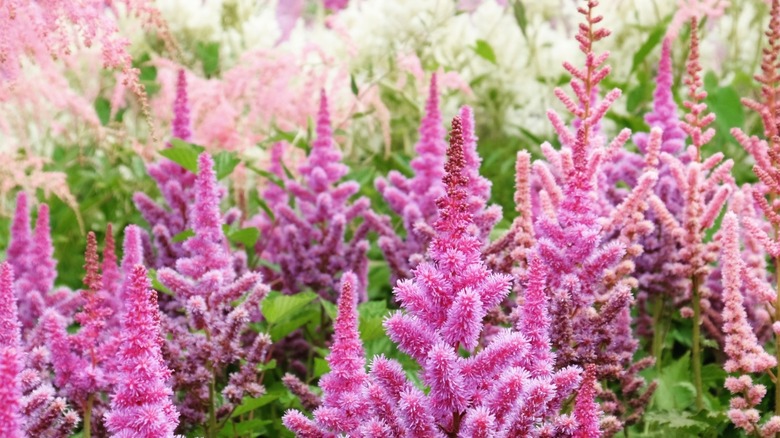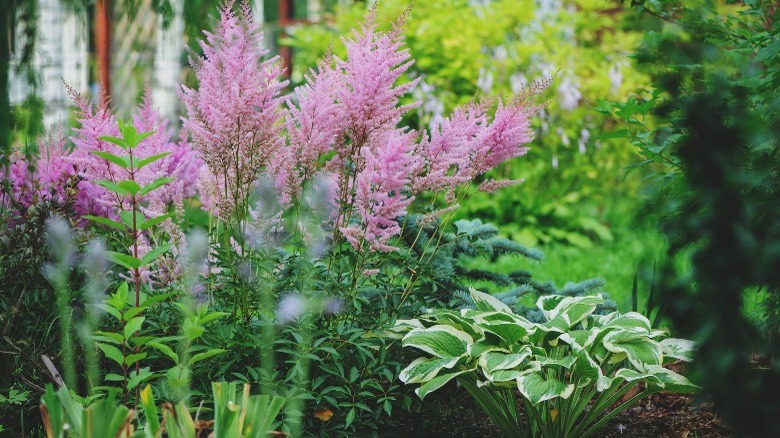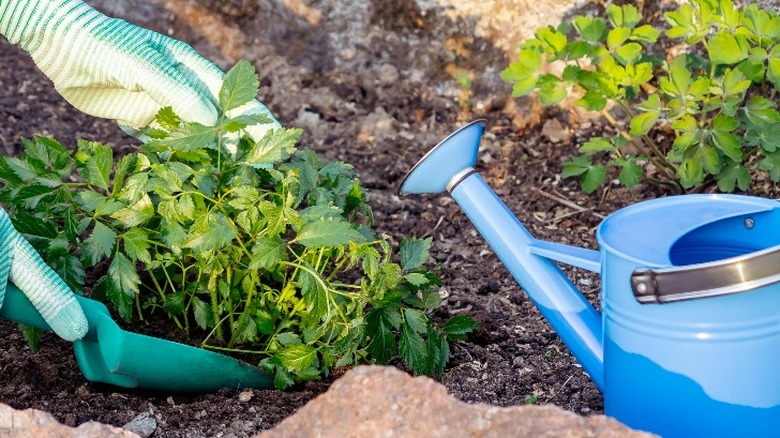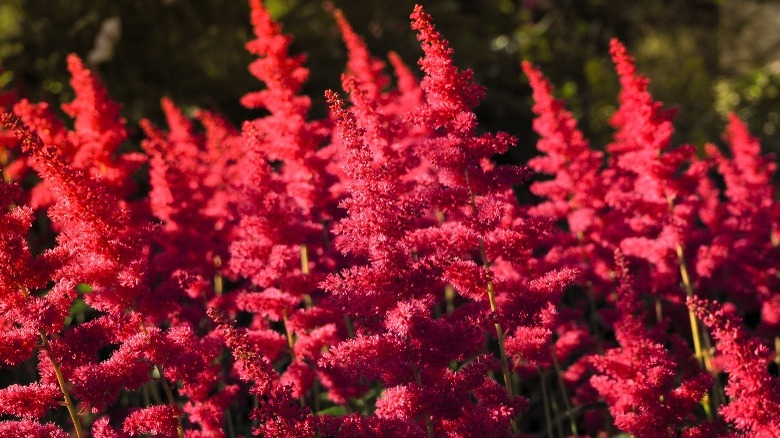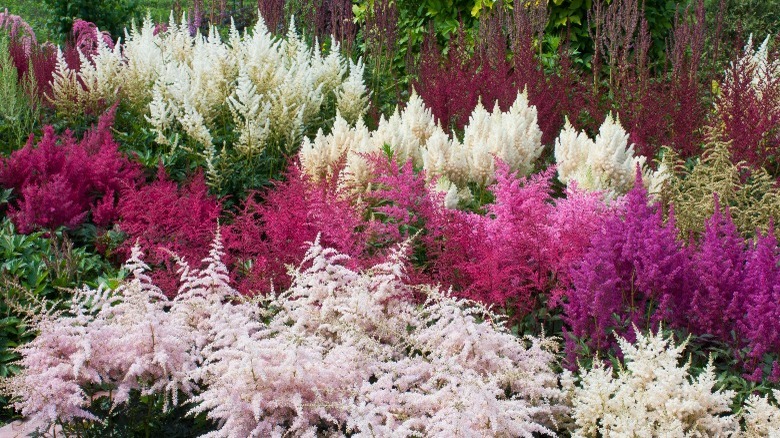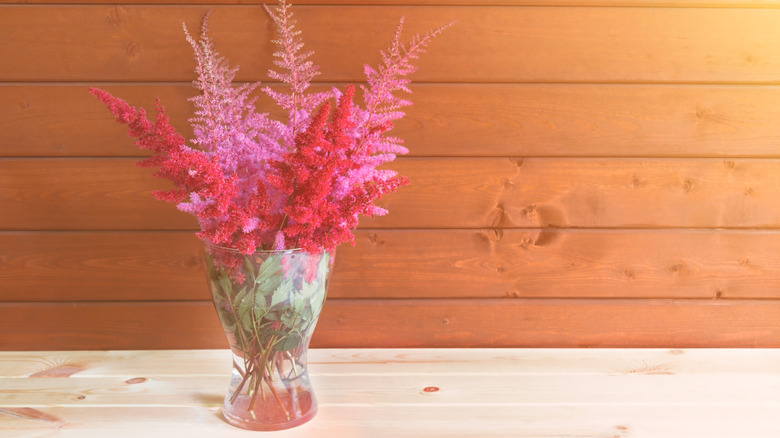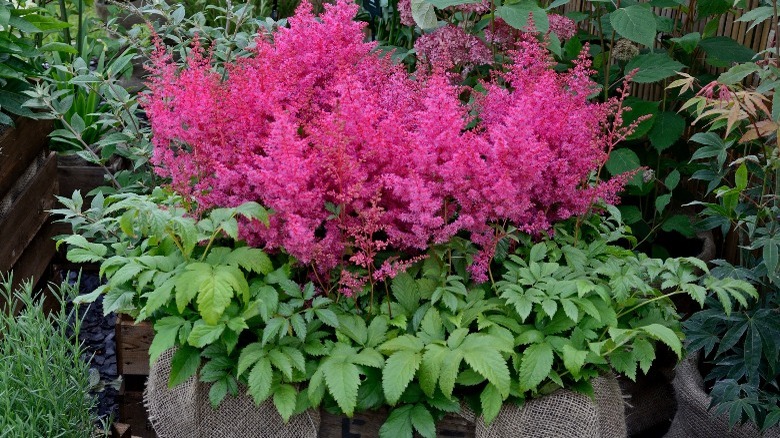How To Grow And Care For An Astilbe Plant
Astilbe, also known as False Goat's Beard, refers to a genus of ornamental perennial plants. It produces tiny flowers that form elegant plumes of vivid color, ranging from snow white to bright fuchsia to velvety crimson. Complementing the blooms are glossy fern-like leaves that shift in color over a single season in some varieties. Introduced to North America from Japan in the late 1800s, astilbe can now be found growing wild in forested woodlands and mountainous ravines in the United States, per Gardening Know How. Since then, it has remained an incredibly popular garden plant, especially as new and exciting hybrids were developed in the 20th century. Today, it is a favorite among gardeners of any skill level and is a great plant for beginners.
Though they differ in color and form, all species of astilbe share similar ideal growing conditions and habitats. They are generally low-maintenance, well-known for their resilience to pests and relative ease of care. The incredible abundance of hybrid varieties ensures you'll be able to find something appropriate for your garden. The greatest challenge would likely be deciding on just one! This guide covers everything you need to know to get started. Read on to learn more about astilbe and start envisioning how it can enhance your outdoor space.
How to use astilbe in your garden
Astilbe plants are rather versatile and are happy to live in garden beds, pots, or riversides. They thrive in damp, shady areas, as excessive sunshine and dry conditions will cause the leaves to wilt or scorch. This makes astilbe an excellent choice for a woodland garden. Since they are shade plants, you can plant them beneath the trees, where dappled sunlight will shine through branches. The leaves will help provide cover from the sun's full force. According to Gardenia, astilbe can survive in full shade but will produce fewer flowers, so plan your garden layout accordingly.
Astilbe can be used to create a striking visual impact. Its height, vivid color, and unique appearance help it stand out even in a mixed bed. The feathery blossoms and lush foliage create a romantic feel perfect for a traditional, cottage-y look. The tall, compact plants look best arranged in groups, and mix well with shorter shade plants such as hostas and coral bells. You can place astilbe behind shorter plants for a full and balanced gardenscape. The low-growing varieties can be planted as colorful ground cover. However they're used, astilbe will attract pollinators such as butterflies, contributing to a beautiful and dynamic ecosystem. Newly planted astilbe may take some time to establish itself, so don't worry if the plant does not bloom in its first year. By its second season it will have adjusted and produce lovely flowers well into the late summer.
How to grow an Astilbe plant
Once you've decided where to place astilbe in your garden, you can start preparing for planting. The best time is the spring, when the soil is cool and damp. According to American Meadows, astilbe seeds can be difficult to germinate, often failing to sprout and take root in the soil. Instead, most people obtain starter plants from a nursery or use divisions from elsewhere in their garden.
Astilbe grows best in shady areas where the soil remains moist and is rich with plenty of organic matter to encourage growth. They prefer slightly acidic soil, with a pH of around 6.0. Place individual plants about 18 to 24 inches apart to give them plenty of space for air to circulate and avoid crowding as they fill in. Astilbe can be propagated by division, recommended every three to five years to manage its spread. Like with planting, the best time is early spring. Start by digging up the root ball, including as much of the root structure as possible. Gently separate the rhizomes into smaller divisions, careful to minimize damage. Next, dig holes about twice as wide and deep as the separated plant, spaced apart as with initial planting. Try to return the transplants to the soil as quickly as possible to keep them from drying out and experiencing transplant shock. Once in place, fill in with soil to completely cover the roots, and water the plant to encourage a healthy adjustment.
How to care for an Astilbe plant
All varieties of astilbe are relatively low-maintenance. Their sunlight tolerance ranges from full shade to full sun but only in cool, northern climates where they receive frequent waterings. According to American Meadows, astilbe should be watered often enough to keep the soil moist, especially during the hottest weeks of summer. If you're having trouble making a determination, you can check the top 1 inch of soil to see if it needs more water. Watering once a week should be sufficient in most climates, though young plants may require more before they've established a strong root system.
Astilbe benefits from fertilizer in the spring, before it blooms. The Spruce recommends using a formula containing phosphorus, as it helps the plant produce flowers starting around mid-summer. Unfortunately, removing spent flowers won't catalyze new blooms, so deadheading is unnecessary aside from aesthetic reasons. As with most perennials, it is best to cut the plant back at the end of the season to help avoid pests and disease. Astilbe plants are generally resilient, but their preference for shade can make them prone to powdery mildew. Powdery mildew is a fungal disease that spreads via spores, covering the affected plant in small white splotches (via Garden Guides). It can be difficult to eradicate once it has infected a plant, so it's best to focus on avoiding it entirely by allowing for space between your plants and pruning when they begin to crowd.
Astilbe plant varieties
The genus Astilbe refers to over 20 different species and numerous hybrids, cultivated to produce exciting flower arrangements. According to How to Garden Advice, many hybrids are credited to German botanist George Arends. Native to the far east, they can be found growing wild in areas of China, Japan, and India. They range in size, the smallest dwarf varieties growing only 6 inches tall while others can easily reach over 3 feet. Most are hardy to USDA zones 4 to 9, but there are, of course, outliers that can thrive outside of that range.
Many species of Astilbe are popular, but Chinese astilbe (A. chinensis) and Japanese astilbe (A. japonica) are among the most commonly grown, according to Garden Design. Some varieties of Astilbe plants include:
- Sprite astilbe (A. simplicifolia hybrid) is a dwarf variety known for its award-winning delicate pink blooms. It reaches a maximum of 24 inches in height and spread and is excellent for ground cover or containers.
- Maggie Daley astilbe (A. chinensis hybrid) is a favorite among gardeners for its intensely vivid purple flowers. It blooms late in the summer, easily attracting butterflies and hummingbirds that are drawn to its bright colors.
- Fanal astilbe (A. x arendsii) grows tall and produces a deep red color with matching foliage for a striking effect.
- Bridal veil astilbe (A. x arendsii) blooms in late spring, earlier than most other varieties. Its lush white flowers create an elegant effect, deepening to ivory before fading entirely.
Is astilbe toxic?
In short, no. Astilbe is entirely non-toxic, making it a safe plant for gardeners with small children and pets. Pests such as deer are also uninterested in the plant. While astilbe may be edible, using the plant for culinary purposes does not seem to be a widespread practice. Certain varieties, however, are believed to have medicinal properties. According to a study published by the National Center for Biotechnology Information, river astilbe (Astilbe rivularis) has been used by communities throughout its native India to address a wide range of medical maladies. Extracts from the rare species have been used to treat hemorrhages, inflammation, and even gastrointestinal diseases. However, the publication stresses that the plant's biological benefits must be further studied before it can be safely endorsed and recommended as a remedy.
Astilbe does not produce a lot of pollen and is a smart choice for people with seasonal allergies. The Old Farmer's Almanac applauds this characteristic and recommends astilbe for this very reason. You can appreciate the colorful growth of your astilbe plant outdoors, or cut flowers to arrange in a vase to add some cheer indoors as well. However you choose to enjoy your Astilbe plants, you can rest assured that they'll provide beauty while remaining harmless to your loved ones, including pets.
How to repot an Astilbe plant
Most plants grown in containers require repotting once they've outgrown their current habitat, and astilbe is no exception. The process is simple but can be stressful to plants if not done correctly. If you're unsure whether or not your plant requires repotting, look for roots growing through drainage holes, or water running through the soil without much moisture retention. These are signs your plant could benefit from more space or new soil.
Start by carefully removing the plant from its current container. If the roots seem tight or compacted, use your fingers to separate them gently and loosen excess soil. Select a new container with a drainage hole that will give the plant 2 to 3 inches more room. Astilbe plants prefer wetter conditions, so Garden Guides recommends a non-porous pot that will retain some moisture. Fill the bottom of the pot with 1 or 2 inches of well-draining potting soil. Place the plant inside the pot, and fill in the remaining space with more soil, careful not to pack it too tightly. When finished, the roots should be fully covered, and the plant's crown should sit just below the rim of the container. Don't forget to water your plant thoroughly after repotting to reduce the risk of transplant shock. In just a few weeks, your potted astilbe should be fully acclimated, and you can enjoy its colorful blooms as it thrives in its new habitat.
